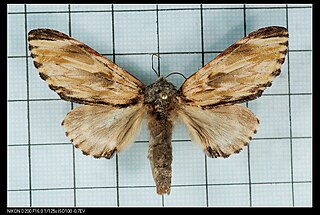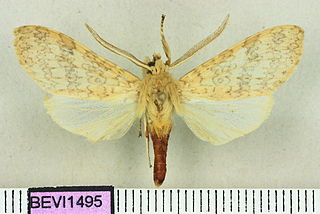
The Coleophoridae are a family of small moths, belonging to the huge superfamily Gelechioidea. Collectively known as case-bearers, casebearing moths or case moths, this family is represented on all continents, but the majority are found in temperate areas of the Northern Hemisphere. They are most common in the Palearctic, and rare in sub-Saharan Africa, South America, and Australia; consequently, they probably originated in northern Eurasia. They are relatively common in houses, they seek out moist areas to rest and procreate.

The genus Calyptra is a group of moths in subfamily Calpinae of the family Erebidae. They are a member of the Calpini tribe, whose precise circumscription is uncertain but which includes a number of other fruit-piercing or eye-frequenting genera currently classified in Calpinae.

The Calpinae are a subfamily of moths in the family Erebidae described by Jean Baptiste Boisduval in 1840. This subfamily includes many species of moths that have a pointed and barbed proboscis adapted to piercing the skins of fruit to feed on juice, and in the case of the several Calyptra species of vampire moths, to piercing the skins of mammals to feed on blood. The subfamily contains some large moths with wingspans longer than 5 cm (2 in).
Calyptra albivirgata is a moth of the family Erebidae first described by George Hampson in 1926. It is found in Asia, including China and Japan.

Calyptra thalictri is a moth of the family Erebidae. It is native to the area ranging from Japan and Korea to China and Malaysia, west through the Urals to Southern Europe, but it has recently expanded its range to northern Europe. In 2000, it was observed in Finland and in 2008 it was recorded even further west, in Sweden.
Calyptra bicolor is a moth of the family Erebidae. It is found in India. It has been known to feed on humans, as well as a variety of other mammals.
Calyptra eustrigata is a moth of the family Erebidae, found in Sri Lanka and Malaysia. It has been reported as exhibiting parasitic blood-sucking behavior.

Calyptra fletcheri is a moth of the family Erebidae. It has been found in China.
Calyptra gruesa is a moth of the family Erebidae. It has been found in China. C. gruesa has a wingspan range of 25 to 29 millimetres.
Calyptra hokkaida is a moth of the family Erebidae. It has been found in China and Japan. The larvae length of C. hokkaido is roughly 40 millimetres (1.6 in).
Calyptra lata is a moth of the family Erebidae. It has been found in Japan and far-east Russia. The larvae length of C. lata is roughly 45 millimetres (1.8 in).

Calyptra minuticornis, the vampire moth, is a moth of the family Erebidae. It has been found in Indonesia, Java, India, Sri Lanka, and Australasia.
Calyptra nyei is a moth of the family Erebidae. It has been found in India.
Calyptra ophideroides is a moth of the family Erebidae. It is found in East Indies. It has been known to feed on humans, as well as a variety of other mammals.
Calyptra subnubila is a moth of the family Erebidae. It has been found in Indonesia.
Calyptra pseudobicolor is a moth of the family Erebidae. It is found in India. It has been known to feed on humans, as well as a variety of other mammals.
Calyptra parva is a moth of the family Erebidae. It is found in India. It has been known to feed on humans, as well as a variety of other mammals.

Calyptra orthograpta is a moth of the family Erebidae. It has been found in China and India. It has been noted to be a relatively rare species.

Neopheosia is a monotypic moth genus of the family Notodontidae described by Shōnen Matsumura in 1920. Its only species, Neopheosia fasciata, was first described by Frederic Moore in 1888. It is found in the Himalayas, Taiwan, Sundaland, Buru and Japan.

Lophocampa secunda is a moth of the family Erebidae. It was described by Walter Rothschild in 1909 under the name fasciata. It is found in Brazil and on Cuba.








